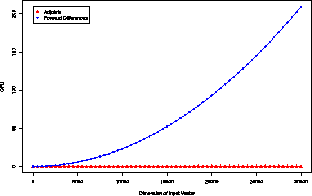
engineering & technology publications
ISSN 1759-3433
PROCEEDINGS OF THE FIFTH INTERNATIONAL CONFERENCE ON ENGINEERING COMPUTATIONAL TECHNOLOGY
Intraprocedural Adjoint Code Generated by the Differentiation-Enabled NAGWare Fortran Compiler
Department of Computer Science, RWTH Aachen University, Germany
Consider the computation of the gradient
![]() of the following
function
of the following
function
![]() that
is due to Griewank [2].
that
is due to Griewank [2].
The classical approach to numerical differentiation uses finite difference quotients to approximate the values of derivatives. Centered finite differences defined by
The computational complexity of the accumulation of the full gradient
by finite difference approximation is
O(n) Every single input needs to be perturbed which turns out to
be infeasible for large n. The solution comes in the
form of reverse mode automatic differentiation [1].
It builds the basis for semantic source transformation algorithms
that generate adjoint code ![]() for the computation of
for the computation of
We describe a research prototype of the NAGWare Fortran compiler that provides intrinsic support for the generation of adjoint code. The functionality is currently limited to the intraprocedural level. A comparison of the runtime behavior of adjoint code for Equation (86) compared with finite difference approximation of the gradient is shown in Figure 1. This figure alone provides enough justification for the considerable development effort that adding adjoint capabilities to a compiler represents.
- 1
- A. Griewank, Evaluating Derivatives. Principles and Techniques of Algorithmic Differentiation, Frontiers in Applied Mathematics, SIAM, 2000.
- 2
- A. Griewank, Generalized descent for global optimization, Journal of Optimization Theory and Applications 34, 11-39, 1981. doi:10.1007/BF00933356
purchase the full-text of this paper (price £20)
go to the previous paper
go to the next paper
return to the table of contents
return to the book description
purchase this book (price £105 +P&P)

